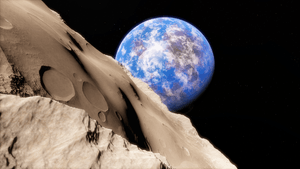SpaceEngine
|
SpaceEngine's logo | |
|
Earth, as rendered in SpaceEngine | |
| Developer(s) | Vladimir Romanyuk |
|---|---|
| Stable release | 0.9.7.3 / 17 April 2015 |
| Development status | Beta |
| Written in | C++ |
| Operating system |
Microsoft Windows Linux (planned) |
| Size | 850 MB |
| Available in | English, Russian, Croatian, French, Italian, Finnish, German, Portuguese, Spanish, Czech, Danish, Turkish, Swedish, Dutch, Romanian |
| Type | Space Simulation |
| License | Proprietary |
| Website |
en |
SpaceEngine (stylized as "Space Engine") is a free 3D astronomy program[1] and game engine developed by Russian astronomer and programmer Vladimir Romanyuk.[2] Using real astronomical catalogs and procedural generation, it creates a three dimensional planetarium representing the entire universe. Users can travel through space in any direction or speed, and forwards or backwards in time.[3] SpaceEngine is in beta status, and is currently freeware for Microsoft Windows. It uses pseudo-random numbers to procedurally create any kind of planetary system, nebula or galaxy.
One of the main features of the program is its scientific accuracy. Cataloged objects are based on real data, while procedural objects are built around the cataloged universe using realistic generation algorithms. Properties of objects, such as temperature, mass, radius, etc., are presented to the user on the HUD and in an accessible information window. Users can observe objects from small spacecraft to galaxy clusters, similar to other simulators such as Celestia. SpaceEngine includes thousands of real objects, including stars from the Hipparcos catalog, galaxies from the NGC and IC catalogs, several well-known nebulae, and all known extrasolar planets and their suns.[4]
Navigation
When using SpaceEngine, a user can freely explore the universe using keyboard and mouse commands, including WASD keys. Through a combination of these commands, a user can fly anywhere they wish. A user may selectively travel to any object in the program's universe by selecting it and using the go-to function to travel there automatically. All of the key commands can be changed in SpaceEngine's settings.
There are three different modes of camera control. Free mode allows movement without inertia, and the user can set a constant velocity to travel when a navigation key is held down. Spacecraft and aircraft modes enable inertia, and the user sets an acceleration rather than a velocity. Users can travel at any velocity they wish, and are not bound by physical limits. The only difference between spacecraft and aircraft mode is that in aircraft mode the direction of motion follows the orientation of the camera.
Objects can be selected either by clicking on them or by searching for and selecting them in a search window.
Wiki and locations
The software has its own built in "wiki" database giving detailed information on every celestial object, and enabling a player to give a custom name or write a description. It also has a locations database where a player can save any position and time in the simulation and load it again in the future.
Procedural Generation
The proclaimed goal of SpaceEngine is scientific realism, and to reproduce every type of known astronomical phenomenon.
It uses star catalogs along with procedural generation to create a universe. The use of procedural generation allows for a much larger universe to explore than similar programs; billions of galaxies can be explored, each with billions of stars, planets and moons.


SpaceEngine can currently generate:
- Any type of star
- Planetary systems, including various types of planets, moons, asteroid belts, etc.
- Surface features of planets including mountains, craters, deserts, etc.
- Nebulae
- Galaxies
- Comets and evaporating planets
- Aurorae
- Black holes
The surfaces on terrestrial planets are generated using an algorithm based on fractal noise. Everything is based on the same seed, which produces the same simulated universe in every computer on which the program runs, making it possible to share locations between users.
Development
Development of SpaceEngine began in 2005,[5] with first public release in June 2010. The software is written in C++. The engine uses OpenGL as its graphical API and uses shaders written in GLSL. The latest version is 0.9.7.2. As development of a new version progresses, the developer shares his development status on a regular basis. In addition to expanding and completing the planetarium software, the developer has also expressed his intention to create games using the engine,[6] and to eventually license the engine to other developers.
Addons
SpaceEngine is easily modifiable and can support a large variety of addons. The online community creates many addons for the program, including high-resolution textures, language localizations, spacecraft models, edited shaders, galaxy models, lens flares effects, and fictional planetary systems. Most addons are posted on the official website forums.
See also
- Procedural generation
- Celestia
- Digital Universe Atlas
- Frontier: Elite II
- Frontier: First Encounters (Elite III)
- Elite: Dangerous
- List of games with Oculus Rift support
References
- ↑ George Dvorsky (July 12, 2011). "New simulation is as close to traveling through space as it gets". io9. Retrieved October 20, 2014.
- ↑ Thomas Tamblyn (October 21, 2014). "Man Builds Massive Virtual Universe You Can Download And Explore". The Huffington Post. Retrieved October 21, 2014.
- ↑ Cara Ellison (March 11, 2013). "2012: A Space Engine". Rock, Paper, Shotgun. Retrieved January 22, 2014.
- ↑ Jonathan O'Callaghan (October 21, 2014). "Now YOU can be a space explorer: Stunning HD space simulator lets you navigate every known planet, star and galaxy in the cosmos". Daily Mail. Retrieved October 21, 2014.
- ↑ "Интервью с разработчиком SpaceEngine - Владимиром Романюком". Elite Games. 12 March 2012. Retrieved 23 March 2014.
- ↑ "Steam Greenlight :: SpaceEngine". Retrieved 23 March 2014.
